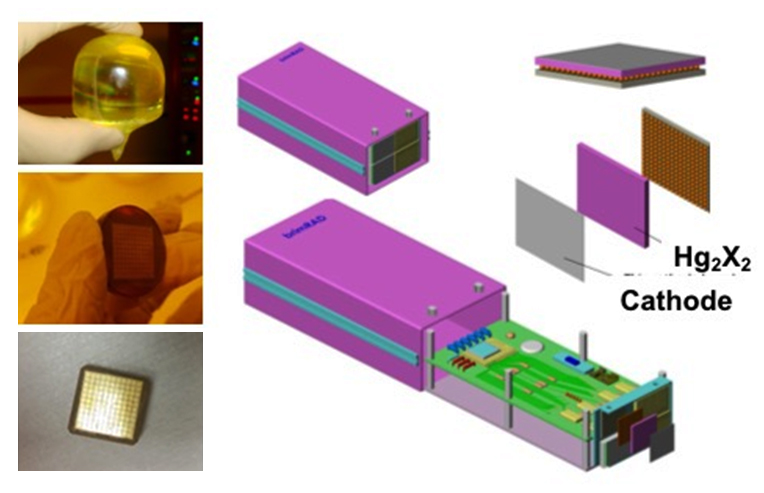Space Exploration Projects
BTC and NASA have been partners in space exploration for many years. Most recently, a BTC spectropolarimeter has been approved to go on planetary missions to identify geological compositions, look for life and explore for new planets in deep space that may support life. A Brimrose instrument is now on the International Space Station, playing a key role in the Cold Atom Laboratory experiment, which is expected to provide scientists with an improved set of tools for probing the realm of quantum mechanics. Other Brimrose components also have been on the Space Station and then re-tested on earth. Brimrose also has built components for satellite use.
Planetology
BTC is developing a space-borne spectrometer system for measuring planetary geochemistry. The space-borne spectrometer system utilizes a single room-temperature semiconductor material based on mercurous halide compounds that can be used to perform both gamma and neutron spectroscopy. Gamma and neutron spectroscopy can provide a probe that penetrates below the optical surface layer to give valuable information regarding the surface composition and the top one to two meters of the regolith structure. This information is complementary to other surface mapping techniques, such as reflectance spectroscopy, surface thermal inertia and mineralogy. Thus, radiation detectors that sense gamma and neutron radiation are critical to the exploration of planetary surface composition. The spectrometer is relevant to missions equipped with “robot”-based in-situ measurement systems, such as Europa Jupiter System Mission (EJSM), Titan Saturn System Mission (TSSM) and any post-2020 Mars-lander.
Mercurous Halide Boule, and Two pixelated detectors (left) and Conceptual drawing of spectrometer for planetary geochemistry.
Other applications for this technology include elemental analysis, explosive detection, medical diagnostics, x-ray imaging, seismic activity detection, and radiation monitoring. Military applications include detection of nuclear non-proliferation, treaty verification, and nuclear materials control. Another application is that of commercial space development, particularly asteroid mining.
For more information contact:
Dr. Susan Kutcher
Brimrose Technology Corporation
composition mapping
BTC is developing an acousto-optic tunable filter-based polarimeter spectral sensor with progressing algorithms for material analysis and mapping. The instrument is a complete polarization analyzer capable of operating over a wide spectral range. We are developing a compact Mueller spectropolarimetry-based instrument for carrying out the test and characterization of a wide range of materials in order to create an extensive database, which can be used for high confidence material discrimination in space based missions.
The developed instrument can be used for analysis and mapping of surface and subsurface soils of planetary bodies, search for water and life on planetary bodies, including outer planets, the detection of exoplanets and identifying if these planets are inhabitable like earth. Mid-wave infrared (MWIR) spectrometer /spectropolarimeter further enhances the capability of classifying asteroids and could identify suitable asteroids for mining, which is one of the future missions of NASA. The instrument can also be used for the detection of camouflaged objects, enemy troops or vehicles, discrimination of materials (natural origin vs man-made), and atmospheric remote sensing.
Spectropolarimetric Imager with SWIR Liquid Crystal Variable Retarders
Data collected using SWIR liquid crystal variable retarders.(Clockwise from top-right) (a) Intensity at 1200nm. (b) Degree of linear polarization. A high degree of polarization on the metal and glass surfaces on the car is seen. (c) Angle of linear polarization. The HSV color space is used with DOLP as the Value parameter.
For more information contact:
Dr. Feng Jin
Brimrose Technology Corporation
410-472-7070
Radiation Shielding
NASA has identified human radiation protection as one of four chief technical challenges for human travel to deep space. BTC uses experimental measurements and computational simulations to determine suitable multi-layered radiation shielding materials for deep space human protection. The targeted application for this technology is to protect humans in aerospace transport vehicles, space stations, orbiters, landers, rovers, habitats, spacesuits, and large space structures. The materials are multi-functional in that while they protect humans from the damaging effects of radiation in space, they also provide structural support for habitats, while still maintaining weight requirements. The materials can also provide radiation shielding to the electronic components on board cargo transportation vehicles and unmanned space vehicles.
Our innovative multi-layered structure (Load-Bearing Multi-Layer Radiation Shielding (LBMLRS)) is a combinations of Ultra-High Molecular Weight Polyethylene (UHMWPE) and ground-breaking ceramic alloy: aluminum magnesium boride (AlMgB14). AlMgB14 outperformed popular load-bearing building materials for space missions such as aluminum and aluminum-lithium alloy on all counts: It is harder, lighter and it blocks GCR and SPE better. LBMLRS performs the best among all the material structures we tested and clearly outperforms those widely used shielding materials in space radiation shielding for improving the GCR exposure by > 11% over ice and the current state-of-the-art radiation shielding material, polyethylene.
Ratio of calculated exposure to GCR with shielding by a slab of various materials of the same thickness (30 cm) to that of PE.
Radiation shielding materials have numerous potential applications in the commercial sector as well. Ionizing radiation is widely used in industry and medicine, and can present a significant health hazard to humans. There are also numerous occupational exposure situations, where it is necessary for personnel to work in a known radiation environment. Furthermore, there are many unexpected situations that may require urgent protective actions, such as an emergency nuclear event, the accidental release of radiologic materials, or the tragic occurrence of a homemade “dirty bomb”. Thus, multifunctional radiation shielding material would be commercially desirable for people who work in the medical industry, particularly nuclear medicine, as well as the nuclear energy industry. These materials are applicable to Department of Defense and Homeland Security where they can protect soldiers, first responders, and emergency medical personnel.
For more information contact:
Dr. Clayton Yang
Brimrose Technology Corporation
410-472-7070
other resources
Brimrose Spectrometer Selected As Part of NASA’s Lunar Payload Development Program
“NIRVSS ABOARD CLPS.” 51st Lunar and Planetary Science Conference (2020).





